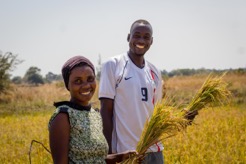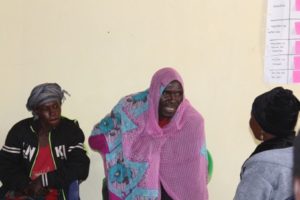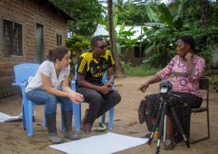
To go beyond socially appropriate responses and understand what is really going on in their project sites, researchers created a medium for participants to narrate the stories behind the data.
Following a recent overview of a Tanzanian research project that uses visual communication to enable farmers to speak up, this article looks at the developments that have been taking place since. Principal Investigator Emily Gallagher explains what has happened with her filmmaking project now that the sugarcane and tea outgrower communities at the center of the research have been visited, interviewed and filmed, and community screenings organized.
As outlined previously, the project uses the methodology of collaborative documentary, from the visual anthropology field, enabling community members take on the role of active collaborators. However, it is not a documentary in which researchers are trying to look through the research subjects’ eyes.
Communities have control over the script and storyboard through an iterative research process that includes surveys and semistructured questionnaires followed by in-depth interviews that took the researchers back to the field with a Tanzanian filmmaker to document the oral histories and daily lives of sugarcane, rice and tea farmers.
“We are using filmmaking as a collaborative method to spark dialogue and fill in the conversational gaps in the narrative. We know what the quantitative data say. We want to create a medium for the research participants to narrate the stories behind the data using participatory activities to get beyond the socially appropriate response to understand what is really going on,” said Gallagher, of the Center for International Forestry Research (CIFOR).
The final step of this process is to take the documentary to a national-level workshop. “The fact that the communities knew that the final film was going to be shown at national level and that we came back to the village three different times meant a lot for the process and the communities. This was crucial. Communities need to feel that there is a benefit for them to dedicate so much of their time,” she added.

Using specific gender-inclusive angles
The methodology also aimed to understand more about the role of gender and social inclusion in the daily lives of male and female sugarcane, rice and tea outgrowers.
“In the beginning we thought that tackling gender issues would be difficult for we mostly saw gender issues pop up during the process and the narrations, for example when we were talking about environmental history, the current landscape narrative, transitions from an existing crop to commodity crop, and the land availability in the community and who gets land, why and how. However, in the end, the film turned out to be a tool to help figure out the gaps in these ‘socially desired’ narratives,” Gallagher explained.
Taking Tanzania, a country with a socialist history, as an example, she suggested that some people might have a cultural mindset in which everything must be or was already equally divided. “In our group interviews, people would respond that all land is divided equally between families, men, women and youth. However, the intra-household data about land access and ownership contradict this egalitarian narrative. Or, for example, during a workshop, we asked a group of men and women whether the land gets divided equally between men and women. And while the men were loudly saying ‘yes’, the women on the other side were dramatically rolling their eyes and responding ‘not at all’. So we can see there is a gap in this narrative, and I try to use the film narratives to fill these gaps.”
Read more: Gender equality and social inclusion
Gender role play
To understand more about these gaps Gallagher decided to use a gender role play methodology to view the current situation of women’s lack of access to land, the fact that women historically do not inherit land, and the general land scarcity for youth. This methodology has been developed by the CGIAR Research Program on Water, Land and Ecosystems (WLE) and works with different scenarios.
The community members were asked to play out what would happen, with one change: the men would play the women’s roles, and the women would play the men’s roles. According to Gallagher, this gives women a new kind of power, as they can show from their own perspectives how they feel women and men are treated in the community.

She used two specific scenarios. The first one was about a young man who was ready to marry. However, both his parents were still healthy and not yet ready to give up their land. The second scenario was of a young widow who had been farming the land of her deceased husband, but his family wanted to take back the land to give to their other son.
In both examples, all kinds of follow-up scenarios came up, such as the healthy parents giving their son the land piece by piece, while he had to share his income with them, and the widowed woman having to marry her brother-in-law to continue having access to the land, or refusing to marry and being asked to leave the land.
These scenarios showed the general understanding among both men and women that it makes more sense to give land to a son than to a daughter, as giving it to a son will ensure the land stays in the family. Giving it to a daughter could lead to her new husband or his family deciding to sell it, or he could pass away and the family of the deceased husband might keep it. And with the current land scarcity, families do not want to run these risks. Furthermore, there is the case of divorce.
“Often in Tanzania people marry only in the traditional way and not through court, so in the case of divorce, the official court rules of equal division of assets do not apply,” said Gallagher. “This is a tense topic, but above all, this is beyond a land issue; it is about a cultural practice and thus extremely hard to change.”
Women left out of supply and value chains
Another moment when it became clear that women, due to a lack of land, had fewer livelihood choices was in value chain exercises. Again, Gallagher made use of different scenarios, in which she talked about the current and past situations, agricultural futures and the changing price of sugarcane.

During the participatory supply chain exercises she asked participants to act out in which part of the supply chain men, women and youth fit. Through this it became clear that women are restricted to activities inside the farmgate and have little influence in decisions beyond the household. Using this information she initiated a discussion about what kind of change needs to happen at every step of the supply chain to make it socially inclusive.
One conclusion was that in general women require access to land, more inclusion in different roles across the supply chains, and more representation in organizations.
Those who tend to be most vulnerable are the women who marry young, and those whose husband passes away before their children are old enough to inherit, as underage children are legally not allowed to inherit land.
Gallagher mentioned that even though there are very few women landowners and it is hard to find female association members, there are some women in powerful positions. Those women appeared to have been put there based on their leadership qualities, which might not be the case for men.
Read more: Gender-responsive methodology for value chain development
Next steps, uptake to the national level
“In general, it was hard for us to cut all that great footage back into something that we could actually share and show and to capture all the issues they thought were important. However, we also noticed that our first target group, the communities, have a lot of patience watching longer videos, especially when it shows familiar faces and voices from their own communities,” said Gallagher.
The next step is for the film to be shown at the national workshop level. This final step has been mentioned throughout the process, so community members know their voices will be heard at national level. Twelve community members will be present at the national level workshop so that they can see how the documentary is received, and what kind of discussion it might provoke.
By Manon Koningstein, FTA Gender Integration Team.
This project is led by the Center for International Forestry Research (CIFOR) under a cross-CGIAR Research Program collaboration with the CGIAR Research Program on Forests, Trees and Agroforestry (FTA), the CGIAR Research Program on Policies, Institutions, and Markets (PIM) and the CGIAR Research Program on Water, Land and Ecosystems (WLE).
This work forms part of the CGIAR Research Program on Forests, Trees and Agroforestry. We would like to thank all donors who supported this work through their contributions to the CGIAR Fund.











